The following is part two of our post on the preferences expressed by respondents to our survey on overnight service. Part 1.
Service Level Preferences
While optimal boarding times vary substantially between different groups of potential passengers, individuals’ expressed convenience and willingness to use overnight buses at different service levels are strikingly similar for almost all groups of respondents.
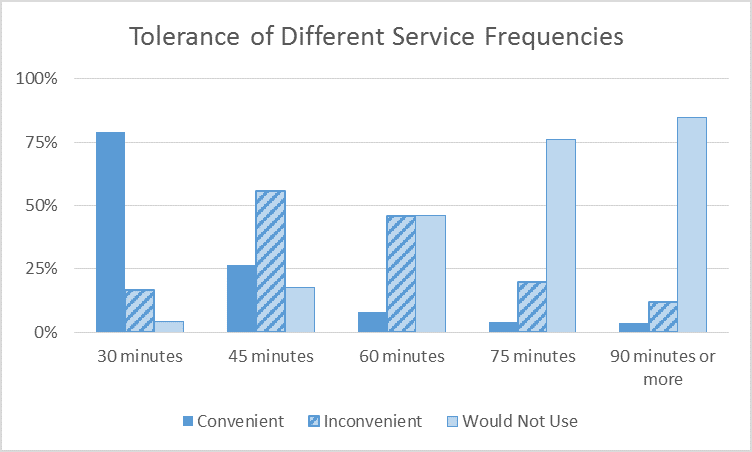
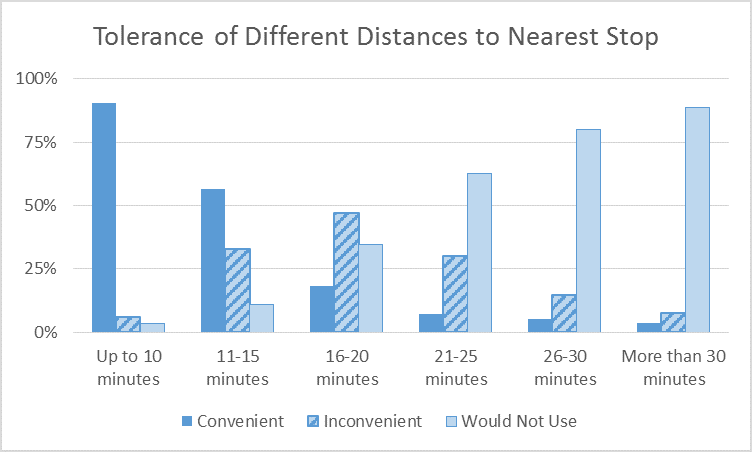
Respondents were asked if they would find service convenient, find service inconvenient but still use it, or not use the service at all at various frequency intervals (times between service) and distances that they would have to walk to the nearest stop. For the group of respondents as a whole, service would have to be provided every 30 minutes for the majority of respondents to find it convenient, and every 60 minutes for the majority to use overnight buses at all. Potential passengers would have to walk a maximum of 11-15 minutes to the nearest stop for the majority to find it convenient, and a maximum of 16-20 minutes for the majority to use overnight buses. Although there are differences in the exact distributions of responses for different subsets of potential passengers, the breaking points at which the majority no longer finds the service convenient and at which the majority would not use the service are remarkably consistent.
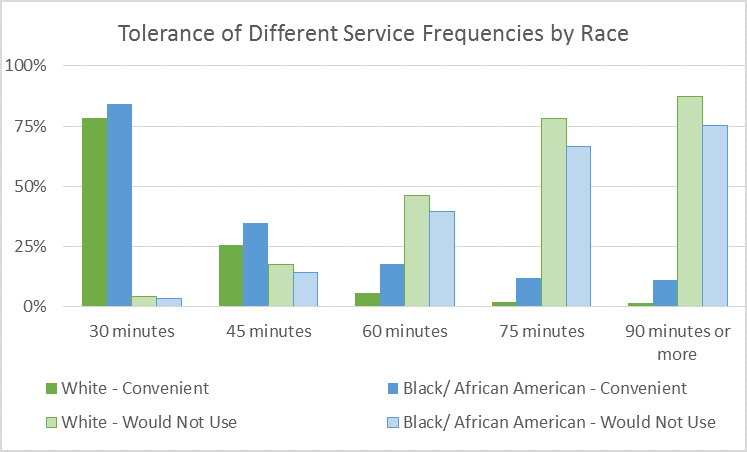
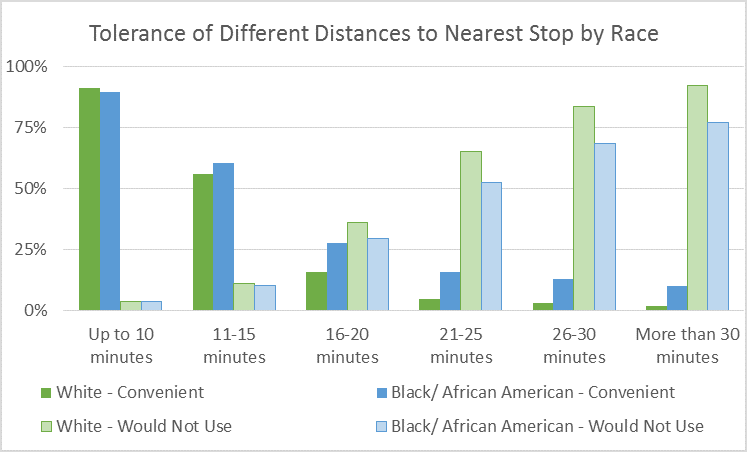
Race: All groups analyzed (White, Black or African American, Asian, Other, and Prefer not to say) have the same breaking points for both service frequency and distance to the nearest stop at which the majority would find service inconvenient and at which the majority would not use it at all. Although there are interesting and statistically significant differences between groups, none of these differences are functionally significant from a service-planning standpoint. For example, if overnight service were provided at 75 minute intervals, 78% of white respondents and 66% of black or African American respondents would not use this service. Although this represents the trend that white (and Asian) respondents are less likely to find service convenient and more likely not to use it than black or African American respondents at almost every level, the difference between the groups is not functionally important; overnight buses running every 75 minutes ultimately do not meet the needs of any group.
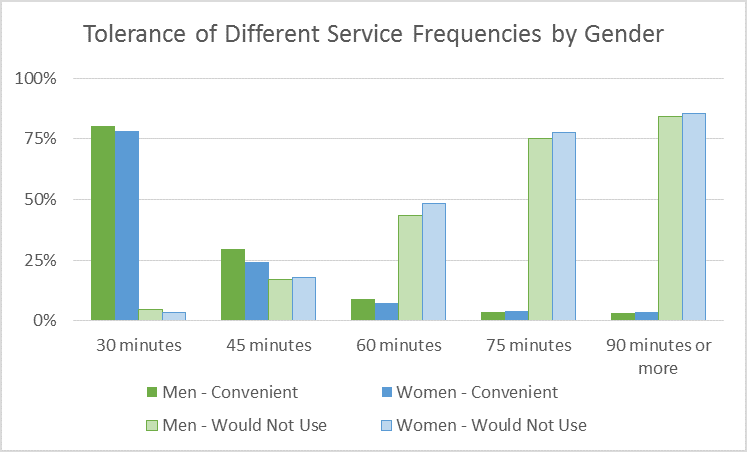
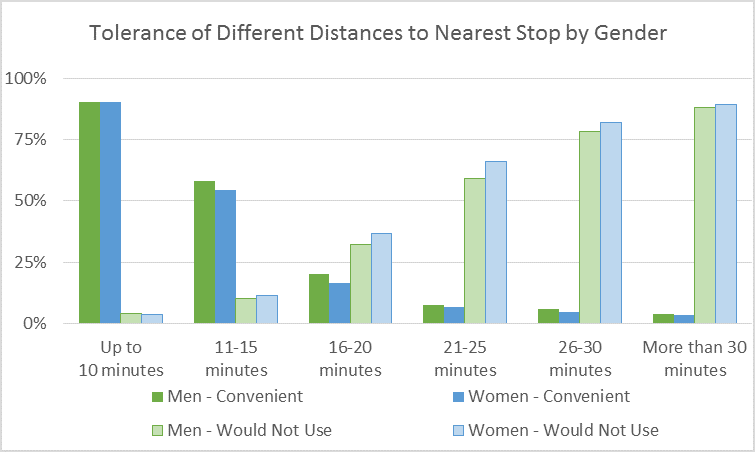
Gender: Similarly, while women are noticeably less likely to find an overnight bus service convenient and noticeably more likely to refuse to use it at almost all service levels, the breaking points identified amongst all respondents in the dataset apply to all groups analyzed (Men, Women, Other, and Prefer not to say.)
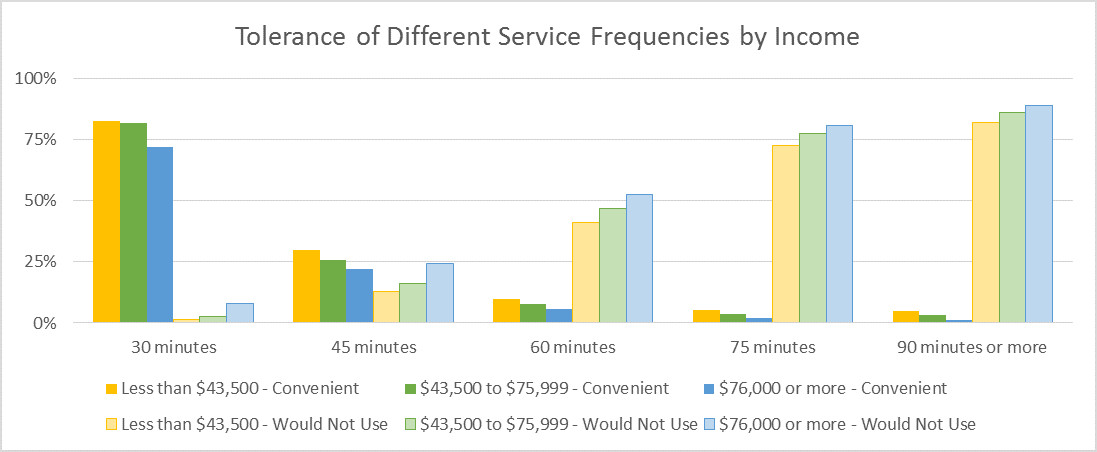
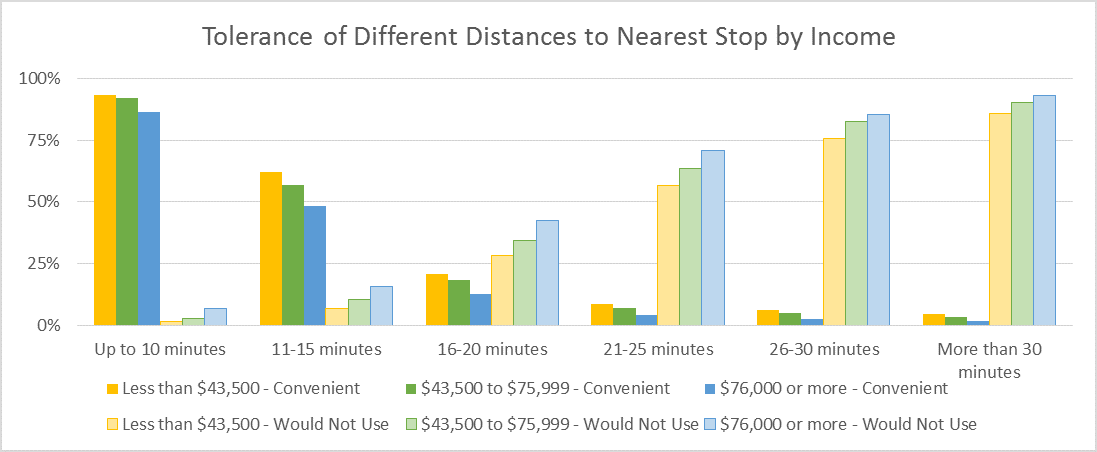
Income: The differences in service level tolerances by income are also minimal. As income rises, respondents are less likely to find service convenient and more likely to be unwilling to use it. Breaking with the preferences of the entire set of potential passengers, at 60 minute intervals, over half of respondents who make $76,000 or more would not use the service (unlike respondents who make under $76,000.) If forced to walk 11-15 minutes, less than half of respondents who make $108,500 or more would find the service convenient (unlike respondents who make under $108,500.) Despite this, however, the differences between income groups are generally relatively small.
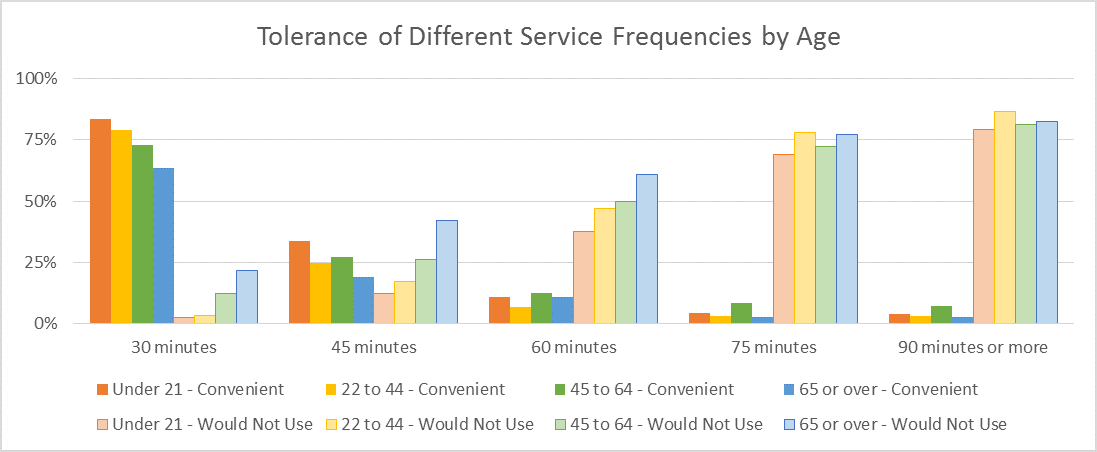
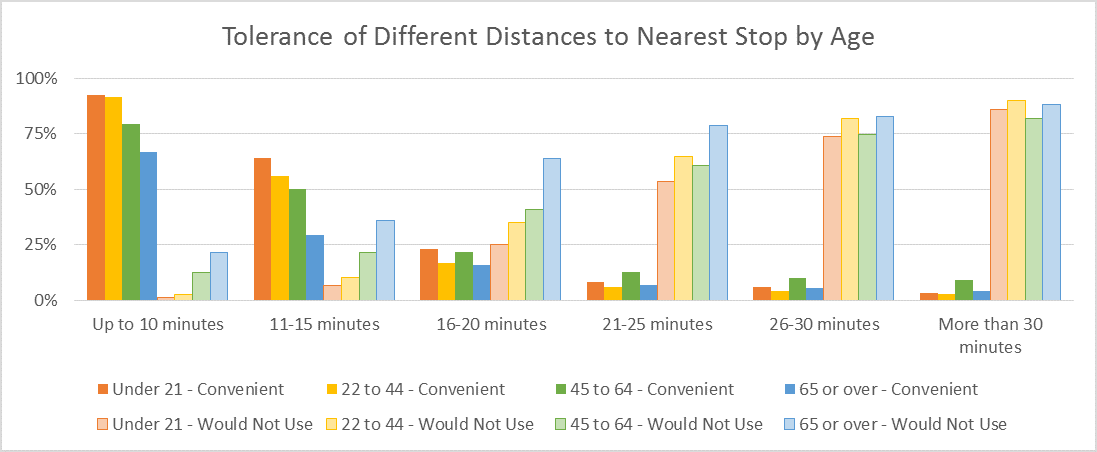
Age: There are slightly more noteworthy differences in service level tolerances of respondents divided by age. Unlike almost every other subset of respondents, the majority of those 65 years of age or older will only find service convenient if they have to walk up to 10 minutes (rather than 11-15 minutes) and will only use the service at all if it is provided at 45 minute intervals (rather than at 60 minute intervals) or they have to walk a maximum of 11-15 minutes (rather than 16-20 minutes). Although respondents 65 years of age or older are more likely to currently never travel between 1AM and 5AM (and respondents who do not currently travel overnight generally have lower levels of tolerance of different service levels), this difference cannot account for their uniquely low levels of tolerance. The subset of respondents 65 years of age or older who currently travel between 1AM and 5AM has the same majority breaking points as all respondents 65 years of age or older. This uniquely low level of tolerance could be because having to walk further or wait outside in the middle of the night represents more of a hardship for individuals 65 years of age or older. Other differences between age groups are noticeable, but not functionally important. At higher levels of service (more frequent service and shorter distances that a passenger would have to walk), tolerances generally fall as age increases. However, at lower levels of service (less frequent service and longer distances that a passenger would have to walk), 22 to 44 year old respondents express notably less convenience and are more likely to not use a service than their 45 to 64 year old counterparts.
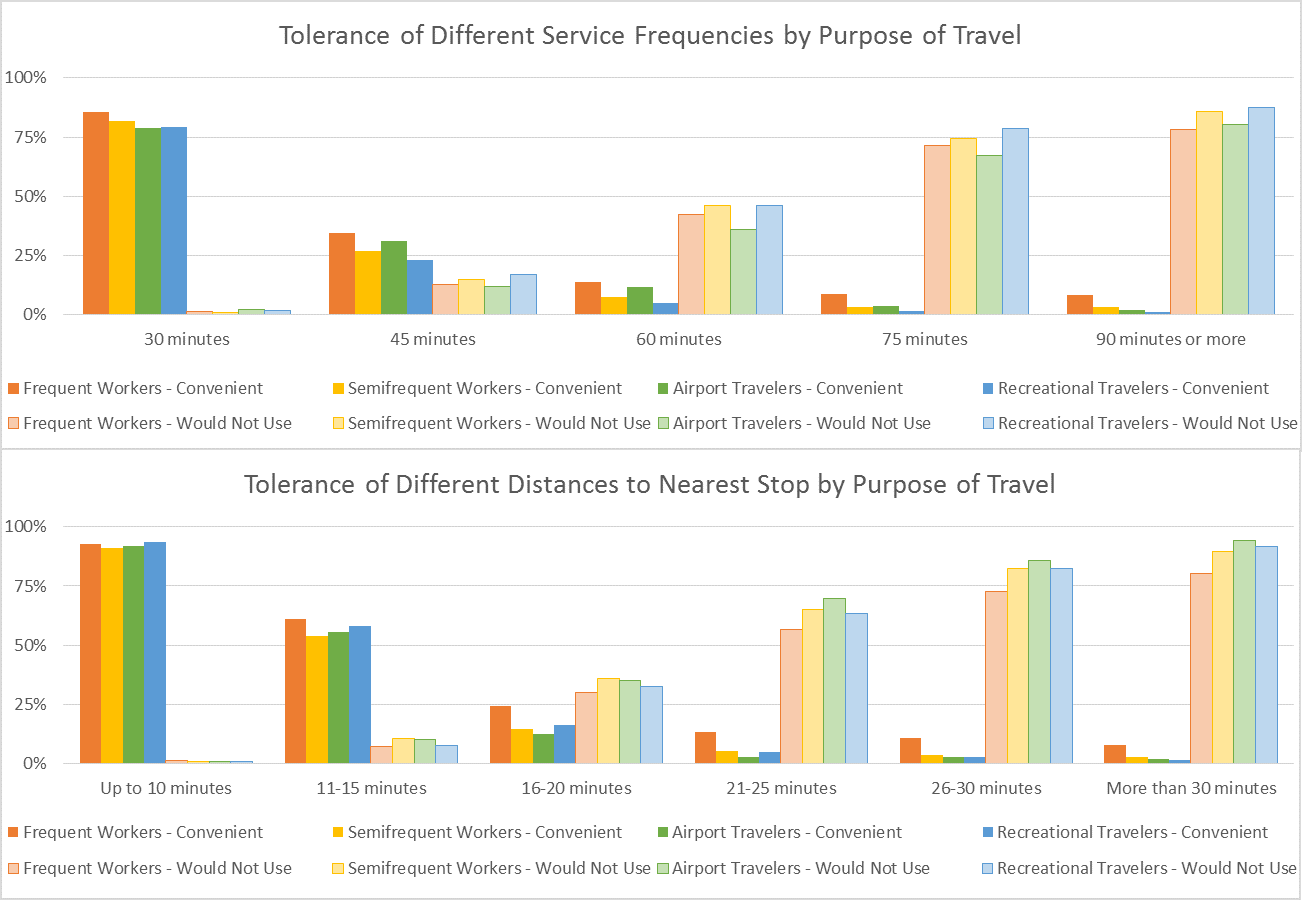
Purpose of Travel: There are surprisingly small differences in the tolerance levels expressed by frequent worker travelers, semi-frequent worker travelers, infrequent worker travelers, recreational travelers, and travelers to the airport. It would be reasonable to expect that these groups would have different levels of tolerance. They probably have levels of flexibility in canceling or rescheduling their trips (for example, it is likely that frequent worker travelers must arrive on time to work, but that recreational travelers can easily modify their behavior,) and different levels of access to alternative forms of transportation (for example, it is likely that travelers to the airport who can afford a plane ticket are more likely to be able to afford a taxi than frequent worker travelers who have nightly overnight shifts.) Despite this, none of the groups divided by purpose of travel depart from the normal breaking points at which the majority of respondents stop finding service convenient or the majority of respondents stop being willing to use the service. Airport travelers appear to be marginally more tolerant of infrequent service but less tolerant of walking longer distances (possibly because they must carry luggage), but even these differences are surprisingly small.
Access to a License and Car: Also surprisingly, the possession of a license and access to a car do not significantly change respondents’ expressed convenience or willingness to use overnight buses at different levels of service. Since licensed drivers who always have access to a private automobile are less likely to be dependent on public transportation than individuals who either do not have a license or who never have access to a private automobile, it would be reasonable to expect that these groups would have different levels of tolerance for different service levels. Comparatively, respondents who have a license and always have access to a car are slightly less tolerant of most service levels than respondents who have a license and share a car with other household members, and respondents who have a license and share a car are slightly less tolerant than respondents who either do not have a license or never have access to a car. These differences, however, are small and generally not functionally important. The only departure from the “normal” breaking points in the full sample of respondents is that the majority (51%) of respondents with a license and consistent access to a car would not use a service provided every 60 minutes, but this is not markedly different from the tolerance of respondents with no car or no license, 43% of whom also would not use overnight buses if provided at this frequency.
Ultimately, although the overnight survey was not completed by a random sample of respondents and its results are not broadly generalizable, the consistency in tolerances of difference service levels across subsets of respondents suggests that their preferences are shared by most potential passengers. An overnight bus system may need to run every 30 minutes with enough routes that users would only have to walk up to 11-15 minutes in order for this service to be found convenient and may need to run every 60 minutes with enough routes that users would only have to walk up to 16-20 minutes for most potential passengers to use it. These parameters should be taken into account when designing and evaluating plans for providing an overnight bus service.